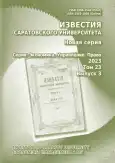Substantiation of structural changes priorities in the Saratov region agro-food complex
- Authors: Yakovenko N.A.1, Ivanenko I.S.1
-
Affiliations:
- Institute of Agrarian Problems – a separate structural subdivision of the Federal State Budgetary Institution of Science of the Federal Research Center “Saratov Scientifi c Center of the Russian Academy of Sciences”
- Issue: Vol 23, No 3 (2023)
- Pages: 269-277
- Section: Articles
- URL: https://journals.rcsi.science/1994-2540/article/view/252126
- DOI: https://doi.org/10.18500/1994-2540-2023-23-3-269-277
- EDN: https://elibrary.ru/RKERJD
- ID: 252126
Cite item
Full Text
Abstract
Keywords
About the authors
Natalia Anatolievna Yakovenko
Institute of Agrarian Problems – a separate structural subdivision of the Federal State Budgetary Institution of Science of the Federal Research Center “Saratov Scientifi c Center of the Russian Academy of Sciences”
ORCID iD: 0000-0002-7589-6302
94 Moskovskaya St., Saratov 410012, Russia
Irina Serafimovna Ivanenko
Institute of Agrarian Problems – a separate structural subdivision of the Federal State Budgetary Institution of Science of the Federal Research Center “Saratov Scientifi c Center of the Russian Academy of Sciences”
ORCID iD: 0000-0002-7877-6568
94 Moskovskaya St., Saratov 410012, Russia
References
- Вартанова М. Л. Региональные аспекты развития агропромышленного комплекса, сельских территорий и продовольственной безопасности // Российское предпринимательство. 2017. Т. 18, № 5. С. 869–886. https://doi.org/10.18334/rp.18.5.37649
- Плотников В. А., Лисицина Е. А. Оценка уровня региональной дифференциации в Российской Федерации // Теория и практика сервиса: экономика, социальная сфера, технологии. 2018. № 2 (36). С. 5–15.
- Коварда В. В., Лаптев Р. А., Гололобова М. А. Перспективы развития импортозамещения в России: региональный аспект // Вестник Алтайской академии экономики и права. 2019. № 10 (ч. 3). С. 45–50. https://doi.org/10.17513/vaael.907
- Béné C. Resilience of local food systems and links to food security – A review of some important concepts in the context of COVID-19 and other shocks // Food Security. 2020. № 12. P. 805–822. https://doi.org/10.1007/s12571-020-01076-1
- Шутьков А. А. Структурные преобразования в аграрном секторе экономики, этапы и результаты: проблемы модернизации и импортозамещения // МИР (Модернизация. Инновации. Развитие). 2017. Т. 8, № 1 (29). С. 31–38. https://doi.org/10.18184/2079-4665.2017.8.1.31-38
- Алтухов А. И. Территориально-отраслевое разделение труда в агропромышленном производстве страны в системе ее продовольственного обеспечения: вопросы методологии и практики // Вестник Курской сельскохозяйственной академии. 2016. № 7. С. 2–8. EDN: WYOHCF
- Кузык Б. Н., Кушлин В. И., Яковец Ю. В. Прогнозирование, стратегическое планирование и национальное программирование : учебник. 4-е изд., перераб. и доп. М. : Экономика, 2011. 604 с.
- Ревенко Л. С., Ревенко Н. С., Солдатенкова О. И. Продовольственные системы Канады: взгляд сквозь призму новых концепций // США & Канада: экономика – политика – культура. 2022. Вып. 2. C. 112–126. https://doi.org/10.31857/S2686673022020080
- Béné C., Oosterveer P., Lamott L., Brouwer I. D., de Haan S., Prager S. D., Talsma E. F., Khoury C. K. When food systems meet sustainability – Current narratives and implications for actions // World Development. 2019. Vol. 113. P. 116–130. https://doi.org/10.1016/j.worlddev.2018.08.011
- Ермолова О. В., Яковенко Н. А., Кирсанов В. В., Иваненко И. С., Остапенко Т. В. Оценка структурных преобразований в агропродовольственном комплексе России // Продовольственная политика и безопасность. 2022. Т. 9, № 1. С. 49–66. https://doi.org/10.18334/ppib.9.1.114347
- Российский статистический ежегодник. 2021 : стат. сб. / Росстат. М., 2021. 692 с.
- Регионы России. Социально-экономические показатели. 2021 : стат. сб. / Росстат. М., 2021. 1112 с.
Supplementary files









